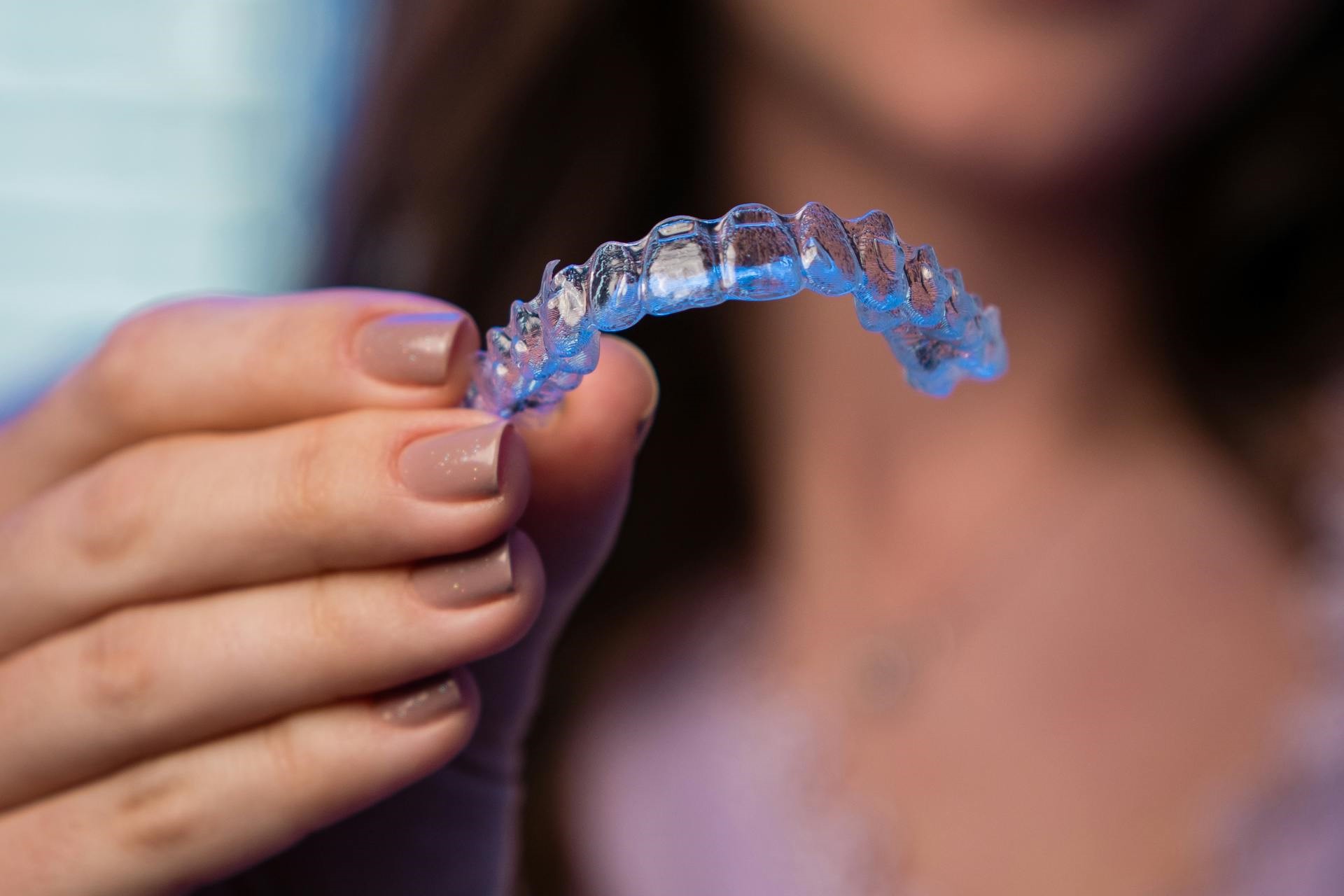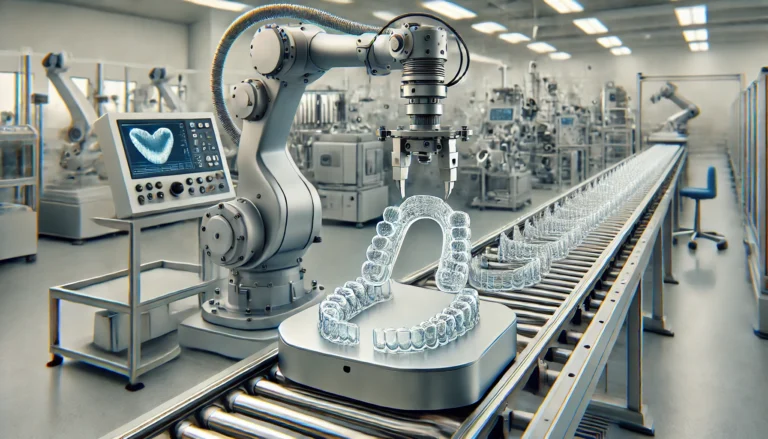
Clear aligners have transformed the field of orthodontics, offering a discreet and comfortable alternative to traditional braces. However, adapting to aligners involves some lifestyle changes that are essential for successful treatment. This guide will explore the 5 lifestyle adjustments to expect with clear aligners, helping you prepare for your orthodontic journey.
From learning how to manage aligner wear time to adjusting eating habits and maintaining proper hygiene, these changes are designed to optimize your results. Additionally, this guide highlights the advantages of clear aligners, such as their removable nature and near invisibility, and compares them to traditional braces.
Whether you’re considering clear aligners or are already using them, this resource provides valuable insights to ensure a smoother experience and a more confident smile.
What Are Clear Aligners?

Clear aligners represent a contemporary orthodontic solution for teeth straightening, providing a discreet and comfortable alternative to traditional braces.
These removable braces are tailored to fit each patient’s unique dental structure, effectively correcting malocclusion and improving dental alignment while maintaining an aesthetically pleasing appearance.
The application of advanced dental technology in the creation of these aligners enables a more convenient treatment plan that caters to individual alignment goals.
How Do Clear Aligners Work?
Clear aligners, like Invisalign, utilise a series of custom-made, transparent trays to gradually shift teeth into the desired position through a carefully planned alignment process. Each tray applies specific pressure, allowing for incremental movement over time.
This method provides an effective and discreet alternative to traditional braces. Many patients considering clear aligners often weigh the cost of Invisalign, noting that while it may require a higher initial outlay, it reflects the advanced technology and personalised treatment plans that ensure optimal results.
With ongoing support from dental specialists throughout the treatment, patients can achieve their desired outcomes with confidence and ease.
What Are the Benefits of Clear Aligners?
The advantages of clear aligners are quite significant, which is why they are becoming a preferred option for busy individuals seeking orthodontic treatment.
These aligners offer enhanced comfort in comparison to traditional braces, and they are removable, making cleaning a doddle. This feature also supports better oral hygiene, as patients can easily maintain their regular oral care routines.
Furthermore, the nearly invisible design of clear aligners boosts confidence by alleviating concerns about aesthetics during the alignment process.
1. Removable
One of the notable advantages of clear aligners is their removable nature, which offers exceptional convenience for individuals in their daily lives. Unlike traditional braces, patients have the flexibility to remove their aligners during meals and special occasions. This allows for a smooth integration into their routines without sacrificing comfort or oral hygiene.
This feature enables individuals to savour their favourite foods, from crunchy apples to chewy caramel, without the worry of damaging their orthodontic appliances. Additionally, during social gatherings, aligners can be discreetly removed, helping to maintain confidence and ensuring that smiles are not hindered by visible braces.
For those who participate in sports or other physical activities, the ability to remove aligners provides peace of mind by minimising the risk of injury. In summary, the removable aspect of these aligners not only facilitates daily activities but also enhances overall quality of life, accommodating personal preferences and lifestyle choices.
2. Virtually Invisible
Clear aligners are crafted to be nearly invisible, enabling patients to undergo orthodontic treatment with discretion while preserving their natural appearance. This characteristic not only enhances self-esteem but also alleviates concerns about one’s appearance during treatment, making it an excellent option for both adults and adolescents.
The aesthetic advantages of clear aligners go beyond surface-level benefits; they also promote increased confidence in social situations. Individuals can engage in conversations, take selfies, and attend events without the distraction or discomfort that often accompanies traditional metal braces.
This nearly unnoticeable orthodontic solution fosters a more positive self-image, encouraging users to smile more freely and actively participate in their social lives.
Consequently, the psychological benefits of choosing clear aligners play a significant role in enhancing overall well-being, allowing individuals to concentrate on their relationships rather than fixating on their treatment.
3. Comfortable
Comfort is a key factor to consider in orthodontic treatment, and clear aligners truly excel in this area by reducing the oral discomfort often experienced with traditional braces. The smooth, plastic material of the aligners minimises irritation to the gums and cheeks, resulting in a more pleasant adjustment period and greater overall satisfaction for patients.
In contrast to traditional braces, which typically involve metal brackets and wires that can lead to pressure sores and discomfort, clear aligners offer a custom fit that enhances wearability. Patients often find that the adjustment periods between aligner changes are less pronounced, as the gradual movement of the teeth allows for smoother transitions.
This gentler approach to orthodontics not only contributes to a more comfortable experience throughout treatment but also promotes better compliance. Individuals are generally more inclined to adhere to their aligner schedule when they feel comfortable and at ease.
4. Easy to Maintain Oral Hygiene
Maintaining oral hygiene is essential during any orthodontic treatment, and clear aligners simplify this process significantly compared to traditional braces. Patients have the advantage of easily removing their aligners for brushing and flossing, which allows them to prioritise their dental health throughout the treatment. This approach reduces the risk of dental issues and promotes better overall oral care.
This flexibility enables individuals to seamlessly incorporate their aligners into their daily dental routines. To keep both their teeth and aligners clean, it is advisable to brush their teeth at least twice a day and floss daily, ensuring that they remove the aligners beforehand.
Regularly rinsing the aligners with lukewarm water and gently brushing them with a soft toothbrush helps prevent any buildup or staining. Additionally, using a cleaning solution specifically designed for aligners can enhance their cleanliness further.
By prioritising these straightforward practices, individuals can ensure that their orthodontic treatment progresses smoothly while effectively safeguarding their oral health.
What Are the Differences Between Clear Aligners and Traditional Braces?

In the realm of orthodontics, it is crucial to understand the differences between clear aligners and traditional braces to make an informed decision regarding treatment options.
Both methods are designed to achieve effective dental alignment and bite correction; however, they differ significantly in terms of approach, comfort levels, and overall impact on the patient experience.
1. Appearance
One of the most attractive features of clear aligners is their appearance, offering a discreet and aesthetically pleasing alternative to traditional braces. Their transparent design allows individuals to smile confidently during treatment without drawing attention to their orthodontic appliances.
This subtlety greatly enhances social interactions, as many patients report feeling more comfortable in both personal and professional settings. In contrast to metal braces, which can sometimes lead to feelings of self-consciousness, clear aligners blend seamlessly into a person’s smile, contributing to an improved sense of self-esteem.
When choosing clear aligners, many patients weigh options like Invisalign vs. ClearCorrect, as both brands offer similar aesthetic benefits but may differ in pricing, treatment flexibility, and material design. Understanding these distinctions can help patients make an informed decision that aligns with their unique orthodontic needs.
As individuals begin their journey towards a more appealing smile, the unobtrusive nature of these aligners—regardless of the brand chosen—promotes overall patient satisfaction. Many appreciate the ability to maintain their natural appearance while pursuing their orthodontic goals, enabling them to focus on enjoying life rather than worrying about their dental aesthetics.
2. Comfort
When considering comfort, many individuals find that clear aligners are often more favourable compared to traditional braces, thanks to their smooth edges and minimal oral discomfort. Unlike braces, which may lead to irritation and soreness, aligners are thoughtfully designed for a gentle fit, significantly enhancing the overall treatment experience.
This careful design not only alleviates pain but also enables patients to maintain their oral hygiene more effectively. The ability to remove aligners while eating or brushing means that individuals do not have to manoeuvre around brackets and wires, which greatly enhances their comfort.
Numerous patients report higher satisfaction levels throughout their treatment journey, enjoying their favourite foods without restrictions and feeling more confident in social situations. Consequently, clear aligners truly represent a modern approach to orthodontics, focusing on both comfort and convenience.
3. Maintenance
Maintaining clear aligners is quite straightforward and user-friendly, as they can be easily removed for cleaning and for regular oral hygiene practices. In contrast, traditional braces require more effort to maintain oral cleanliness, which can pose a challenge for some patients.
For those using aligners, the ability to take them out during meals allows for thorough brushing and flossing without the obstructions caused by brackets and wires. This flexibility encourages better oral hygiene, allowing patients to maintain a regular routine without the need for special tools or techniques.
Clear aligners can be cleaned effortlessly with a toothbrush and mild soap or specific cleaning solutions, ensuring they remain free from stains and odours. This not only contributes to a healthier mouth but also enhances the overall wearing experience, making aligners an attractive option for individuals seeking both effectiveness and convenience in their orthodontic treatment.
What Are the Lifestyle Adjustments to Expect with Clear Aligners?

Adopting clear aligners requires several lifestyle adjustments that are crucial for achieving optimal treatment results and maintaining dental health.
While these aligners provide significant benefits, patients should be prepared to modify their eating habits, oral hygiene routines, and the frequency of dental visits to accommodate their new orthodontic treatment.
1. Eating Habits
Adjusting one’s eating habits is essential when using clear aligners, as these removable braces need to be removed during meals to avoid restrictions and protect them from damage. Patients should be mindful of their food choices to ensure the longevity of their aligners and maximise the effectiveness of the treatment.
To maintain optimal oral health and ensure the aligners function properly, individuals should avoid sticky, hard, and chewy foods that could compromise the integrity of the aligners or lead to plaque build-up.
- Common offenders include chewing gum, toffee, and nuts, which can easily get stuck between the teeth and aligners.
It is also wise to avoid dark-coloured beverages such as coffee or red wine, as these can stain both the teeth and the aligners.
Instead, it is beneficial to focus on softer foods that are easier to handle, such as yoghurt, smoothies, or mashed potatoes. Staying hydrated with water is crucial; rinsing the mouth after eating helps prevent any residue from impacting oral hygiene.
Ultimately, by making these dietary adjustments, patients can enhance their overall experience and outcomes while wearing clear aligners.
2. Oral Hygiene Routine
Establishing a strong oral hygiene routine is essential for anyone using clear aligners. This practice not only supports dental health but also helps maintain the clarity of the aligners. It is important for patients to commit to regular brushing and flossing, as well as cleaning the aligners to prevent plaque build-up and ensure optimal oral hygiene.
This routine is effective in avoiding cavities and gum disease, and it also significantly enhances the overall effectiveness of the alignment process. Brushing your teeth at least twice a day with fluoride toothpaste is key to removing food particles and harmful bacteria. Additionally, daily flossing is crucial for clearing debris from between the teeth, where toothbrushes often struggle to reach.
Cleaning the aligners with a gentle cleanser or soap and rinsing them with lukewarm water helps prevent discolouration and ensures a more comfortable fit. Adhering to these thorough cleaning instructions will greatly contribute to achieving a bright, healthy smile while using clear aligners.
3. Speech Changes
When individuals first begin using clear aligners, they may notice some changes in their speech as their mouth adjusts to the new presence of the aligners. This is a common experience during the initial adjustment period and typically resolves as one becomes more accustomed to speaking with them in place.
Many users report that their speech may feel somewhat affected, often presenting as a slight lisp or difficulty in articulating certain sounds. It is important to keep in mind that this effect is usually temporary.
As individuals consistently wear the aligners, they gradually adapt, which leads to smoother communication. Engaging in regular practice, such as reading aloud or conversing with friends, can significantly facilitate this transition.
Over time, speech clarity tends to improve, and any initial discomfort decreases, allowing users to regain their confidence in verbal communication throughout the course of their treatment.
4. Discomfort and Soreness
Experiencing some discomfort or soreness is a normal part of the clear aligner treatment process, particularly during the adjustment periods when new aligners are introduced. This discomfort is generally manageable and serves as an indication that the aligners are effectively moving your teeth into the desired position.
For many individuals on this journey, mild pain or sensitivity can arise as a natural response to dental realignment. During the initial days of each new set of aligners, it is common to feel pressure in the mouth, which may understandably cause concern. It is important to recognise that this sensation is simply a signal that progress is being made.
To alleviate these feelings, applying a cold compress, taking over-the-counter pain relief, or opting for softer foods can be quite helpful.
Typically, this discomfort will subside after a few days, and many patients report a return to comfort as their mouths adjust to the changes. This marks a positive step towards achieving the desired smile.
5. Follow-up Appointments
Regular follow-up appointments with your dental specialist are essential for ensuring the success of your clear aligner treatment plan. These visits provide your orthodontist with the opportunity to monitor your progress, make necessary adjustments, and offer ongoing support throughout the duration of your treatment.
During these appointments, you can expect a comprehensive assessment of how well your aligners fit and function, confirming that your teeth are moving as intended. These visits also allow the dental team to address any concerns or discomfort you may be experiencing, highlighting the importance of adhering to the treatment schedule.
By following the recommended plan and attending your follow-up appointments, you significantly increase your chances of achieving the desired results in a timely manner. This proactive communication fosters a strong relationship between you and your dental specialist, ultimately leading to a more personalised and successful treatment experience.
How Long Does It Take to See Results with Clear Aligners?
The duration of treatment with clear aligners can vary significantly depending on individual alignment goals and the severity of dental conditions. However, many patients begin to see noticeable results within just a few months. Understanding the expected timeline for treatment is important, as it helps manage patient expectations and keeps motivation levels high throughout the alignment process.
Most treatment plans generally range from six months to two years, but several factors can influence this duration. For example, a patient’s age, overall dental health, and their commitment to wearing aligners for the recommended hours each day are all crucial elements that determine how quickly results can be achieved.
It is essential for patients to maintain realistic expectations about their treatment journey. Recognising that consistent wear, regular check-ins with the orthodontist, and a clear understanding of individual alignment goals are vital for achieving the desired outcomes can make a significant difference.
By fostering clear communication, dental professionals can assist patients in navigating their alignment process with confidence, ultimately leading to successful treatment results.
How to Maintain Results after Completing Treatment with Clear Aligners?

After completing treatment with clear aligners, it is essential to maintain the results achieved for long-term dental health and alignment. This typically involves the use of retainers, which play a vital role in stabilising tooth movement and preventing any regression of the aligned teeth.
Using retainers allows individuals to preserve their new smile, ensuring that the effort invested in their orthodontic journey yields lasting benefits. Consistency is crucial; wearing retainers as prescribed can effectively prevent the teeth from drifting back to their original positions.
Additionally, ongoing dental care practices, such as regular check-ups and proper oral hygiene routines, further enhance the benefits gained through aligner treatment. It is also important to adopt a mindful approach to food choices, as certain substances can impact both aligners and retainers.
By adhering to these guidelines and remaining committed to post-treatment compliance, individuals can enjoy a stable and beautiful smile for years to come.
Frequently Asked Questions
1. What are clear aligners and how do they work?
Clear aligners are plastic trays that are custom-made to fit your teeth and gradually shift them into the desired position. They work by applying gentle, constant pressure on the teeth to move them into alignment.
2. How many lifestyle adjustments can I expect with clear aligners?
You can expect five main lifestyle adjustments when using clear aligners to straighten your teeth.
3. Will I need to change my diet while using clear aligners?
You may need to make some adjustments to your diet while using clear aligners. It is important to avoid sticky or hard foods that can damage the aligners and prolong your treatment time.
4. Do I need to remove my clear aligners when drinking or eating?
Yes, it is important to remove your aligners when consuming food or drinks, except for water. This will prevent staining and damage to the aligners.
5. Can I continue playing sports or musical instruments with clear aligners?
Yes, you can continue playing sports and musical instruments with clear aligners. However, you may need to remove them during certain activities to prevent damage.
6. How often do I need to wear my clear aligners?
It is recommended to wear your clear aligners for 20-22 hours per day, only removing them for eating, drinking, and brushing your teeth. Consistent wear is key for the aligners to be effective.






